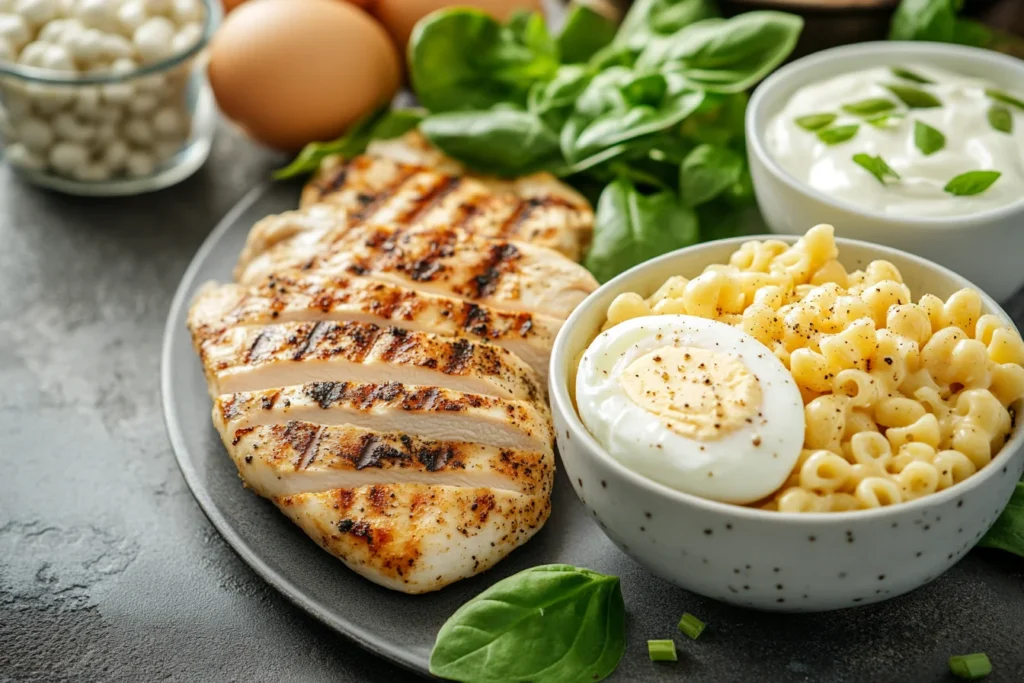Introduction
Mac and cheese is a timeless comfort food, loved by many across different age groups. Known for its creamy texture and satisfying flavor, it’s a dish often associated with indulgence. But when considering its place in a balanced diet, many wonder: is mac and cheese a good source of protein? This article explores the protein content in mac and cheese while providing an in-depth nutritional breakdown and comparison to other foods.
What Is Mac and Cheese?
Mac and cheese, short for macaroni and cheese, is a dish traditionally made with cooked macaroni pasta and a rich cheese sauce. Its variations range from homemade recipes to convenient boxed versions. The dish combines simple ingredients into a hearty meal, making it a staple in many households worldwide.
Learn more about how different pasta dishes can shine by exploring steak and pasta pairing ideas for a perfect mealtime balance.
The Popularity of Mac and Cheese
The widespread appeal of mac and cheese can be attributed to its versatility and convenience. Whether served as a main course or a side dish, its creamy texture and customizable flavor profiles have made it a favorite for both children and adults. Despite its widespread appeal, many wonder about the mac and cheese protein content and whether it contributes meaningfully to daily nutritional goals.
Why Discuss Its Protein Content?
Protein is an essential macronutrient required for muscle growth, tissue repair, and overall health. As people seek convenient, protein-rich meals, understanding the protein content in mac and cheese becomes important. This analysis helps determine whether this beloved dish aligns with dietary needs and goals.
Nutritional Overview of Mac and Cheese
Macronutrients in Mac and Cheese
Mac and cheese is primarily composed of three macronutrients: carbohydrates, fats, and proteins. Each plays a distinct role in its nutritional profile.
- Carbohydrates: A significant portion comes from pasta, providing energy.
- Fats: The cheese sauce contributes saturated fats for flavor and texture.
- Protein: The protein content comes mainly from the cheese and, to a lesser extent, the pasta.
Understanding these components highlights the dish’s strengths and weaknesses from a nutritional perspective.
Carbohydrates in Mac and Cheese
Carbohydrates form the foundation of mac and cheese, derived from the macaroni pasta. A standard serving typically contains 30–40 grams of carbohydrates, offering a quick energy source. However, this high carbohydrate content can be problematic for those on low-carb or ketogenic diets. Adding protein-rich ingredients can help balance the dish’s macronutrient ratio.
Fats in Mac and Cheese
The creamy texture of mac and cheese is achieved through its fat content, predominantly from cheese and butter. While fats are an essential part of a balanced diet, they can contribute to high caloric density. A typical serving can contain 10–15 grams of fat, including saturated fat, which should be consumed in moderation. Choosing low-fat cheeses or alternatives can reduce this.
Protein Content
The mac and cheese protein content varies depending on preparation. A standard serving provides approximately 7–10 grams of protein, primarily from cheese. While this contributes to daily protein intake, it falls short compared to lean meats or legumes. Boosting the protein content with additional ingredients like chicken or tofu can make it a more balanced option.
Caloric Content
A typical serving of mac and cheese contains 300–400 calories, depending on the recipe or brand. The calorie density comes from its high carbohydrate and fat content. For those monitoring calorie intake, portion control or substituting lower-calorie ingredients can make this dish more suitable for specific diets.
Comparison to Other Popular Dishes
When compared to other meals, mac and cheese ranks lower in protein density:
- Chicken breast: Approximately 30 grams of protein per 3-ounce serving.
- Eggs: Around 6 grams of protein per egg.
- Lentils: Offering 18 grams of protein per cooked cup.
These comparisons highlight why mac and cheese protein may not suffice as a primary protein source without enhancement.
Understanding Protein
What Is Protein?
Protein is one of the three essential macronutrients, made up of amino acids, which are the building blocks of the body. It plays a critical role in maintaining muscles, repairing tissues, and supporting vital functions like hormone production and immune response.
Why Is Protein Essential?
Protein is essential for:
- Building and repairing muscles.
- Supporting immune health.
- Providing energy when carbohydrates and fats are insufficient.
Meeting daily protein requirements is crucial for overall health, and incorporating a variety of protein sources helps achieve a balanced diet.
Sources of Protein
Protein can be derived from both animal and plant-based sources. Common examples include:
- Animal-based sources: Chicken, fish, eggs, and dairy products like cheese.
- Plant-based sources: Lentils, chickpeas, tofu, and quinoa.
While cheese in mac and cheese provides some protein, it’s relatively low compared to lean meats or legumes. Fortifying mac and cheese with protein-rich add-ins can bridge this gap.
Is Mac and Cheese a Good Source of Protein?
Mac and cheese is a cherished comfort food, but its nutritional profile often sparks debate. While its creamy texture and rich flavor make it a favorite, many wonder if mac and cheese protein content is enough to qualify it as a good protein source. This article explores the protein levels in mac and cheese, compares it to other foods, and offers strategies to enhance its nutritional value. Let’s dive into the details and discover whether mac and cheese can play a meaningful role in a protein-focused diet.
Protein Content in Homemade Mac and Cheese
Homemade mac and cheese can vary in nutritional value depending on the ingredients used. Typically, cheese serves as the primary contributor to mac and cheese protein. A cup of homemade mac and cheese provides approximately 8–12 grams of protein, depending on the amount and type of cheese included.
- Cheese Selection: Hard cheeses like cheddar are richer in protein, while soft cheeses like cream cheese offer less.
- Milk and Butter: These ingredients add creaminess but contribute minimally to the overall protein content.
Although homemade versions offer some protein, they are often higher in carbohydrates and fats, making them less balanced. Adding extra protein-rich ingredients can significantly boost their nutritional profile.
Protein in Store-Bought and Instant Versions
Store-bought and instant mac and cheese are popular for their convenience, but their protein content tends to be lower than homemade options. On average, these products contain 7–9 grams of protein per serving.
- Powdered Cheese Mix: Instant versions rely on powdered cheese, which contains less protein than fresh cheese.
- Enriched Varieties: Some brands fortify their mac and cheese with added protein, increasing the content to 12–15 grams per serving.
While convenient, store-bought mac and cheese often includes processed ingredients that may not align with health-focused dietary goals. Choosing high-protein or whole-grain versions can improve their nutritional quality.
Protein Comparison to High-Protein Foods

When comparing mac and cheese protein to other high-protein foods, it becomes evident that this dish falls short as a primary protein source. Here’s how it stacks up:
- Chicken breast: 31 grams of protein per 3 ounces.
- Eggs: 6 grams of protein per large egg.
- Greek yogurt: 10 grams of protein per 100 grams.
- Lentils: 18 grams of protein per cooked cup.
Mac and cheese provides less protein per serving, making it a less efficient choice for those focused on protein intake. Enhancing the dish with additional ingredients can help close this gap.
The Role of Cheese as a Protein Source

Cheese is the main contributor to mac and cheese protein levels. It contains casein, a high-quality protein that supports muscle repair and growth. However, not all cheeses are created equal:
- High-Protein Cheeses: Cheddar, Parmesan, and mozzarella are excellent choices for boosting protein content.
- Low-Protein Cheeses: Soft cheeses like brie or cream cheese contribute less protein per serving.
Incorporating a mix of cheeses or increasing the cheese quantity can elevate the protein levels in your mac and cheese without sacrificing flavor.
Enhancing the Protein in Mac and Cheese
Adding Protein-Rich Ingredients

Adding high-protein ingredients to mac and cheese is an effective way to increase its nutritional value. Some excellent options include:
- Grilled chicken or turkey
- Crumbled tofu or tempeh
- Ground beef or turkey
- Legumes like chickpeas or lentils
These additions can transform mac and cheese into a protein-packed meal.
Choosing High-Protein Pasta
High-protein pasta is made from ingredients like lentils, chickpeas, or quinoa, offering a better macronutrient balance. A serving of these alternatives can provide 12–15 grams of protein, compared to 7 grams in traditional pasta.
Incorporating Protein Powders or Supplements
Adding unflavored protein powder to the cheese sauce is a seamless way to enhance mac and cheese protein levels. Collagen or whey protein blends well into the sauce, boosting protein content without altering taste.
Pairing with Protein-Rich Side Dishes
Pairing mac and cheese with protein-rich sides can create a balanced meal. Consider these options:
- Grilled salmon or shrimp
- Hard-boiled eggs
- A side salad with quinoa and beans
These pairings complement mac and cheese, ensuring you meet your protein goals. Looking to elevate your mac and cheese with wholesome alternatives? Check out the best cut of steak for pasta to create a protein-rich pairing.
Health Considerations
Mac and Cheese in a Balanced Diet
Mac and cheese can fit into a balanced diet when consumed in moderation. Its protein content, while moderate, supports dietary diversity. However, prioritizing nutrient-dense ingredients is key to maximizing its benefits.
The Impact of Processed Ingredients
Many store-bought mac and cheese options contain processed ingredients like artificial flavors and preservatives. These can detract from the dish’s overall nutritional quality. Opting for homemade versions or cleaner brands can minimize these concerns.
Managing Portion Sizes
Portion control is essential, as mac and cheese is calorie-dense. Keeping servings to 1 cup and balancing the meal with vegetables or lean proteins can help maintain dietary balance.
Tips for a Healthier Mac and Cheese
Opt for Whole-Grain Pasta
Whole-grain pasta provides more fiber and micronutrients than traditional options, improving the dish’s overall nutritional profile.
Use Low-Fat Cheese
Replacing full-fat cheese with low-fat alternatives reduces calories and saturated fat while maintaining mac and cheese protein levels.
Incorporate Vegetables
Adding vegetables like broccoli, spinach, or peas enhances the dish’s vitamin and mineral content. These additions also add texture and flavor.
Conclusion
Is Mac and Cheese Good Overall?
While mac and cheese contains protein, it is not a high-protein dish on its own. The protein content in mac and cheese comes primarily from cheese, which contributes a moderate amount.
Final Thoughts on Its Role in a Balanced Diet
Mac and cheese can be part of a balanced diet when enhanced with protein-rich ingredients and mindful portioning. By incorporating strategies like adding lean meats, using high-protein pasta, or pairing with nutritious sides, this classic comfort food can be transformed into a more protein-rich and satisfying meal.


2 thoughts on “Mac and Cheese Protein: Is It a Good Source of Protein?”